
Two Nigerian refugees cry and embrace in a detention center for refugees in Surman, Libya 17 August 2016. The detention center houses hundreds of women escaping precarious conditions. Many claim they are regularly beaten or sexually assaulted, and receive insufficient amounts of food and water at the center. Most of these women were attempting to reach Europe by being smuggled across the Mediterranean in boats setting sail from neighboring Sabratah. (Photo by Daniel Etter/Reuters/Courtesy of World Press Photo Foundation)
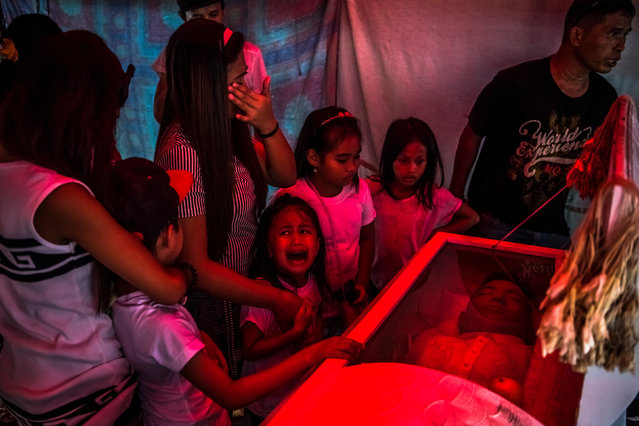
Six-year-old Jimji cries in anguish as she screams "papa" before funeral parlor workers move the body of her father, Jimboy Bolasa, from the wake at the start of the funeral to Navotas Cemetery in Manila, Philippines. Unidentified men abducted Mr. Bolasa and a neighborhood friend one night. Less than an hour later, their beaten bodies, with signs of torture and gunshot wounds, were dumped under a nearby bridge. The police claim the men were alleged drug dealers while their family members say they had only surrendered themselves. (Photo by Daniel Berehulak/Reuters/The New York Times/Courtesy of World Press Photo Foundation)

The Iraqi Special Operations Forces search houses of Gogjali, an eastern district of Mosul, looking for Daesh members, equipment, and evidence on 2 November 2016. (Photo by Laurent Van der Stockt/Getty Reportage for Le Monde/Courtesy of World Press Photo Foundation)
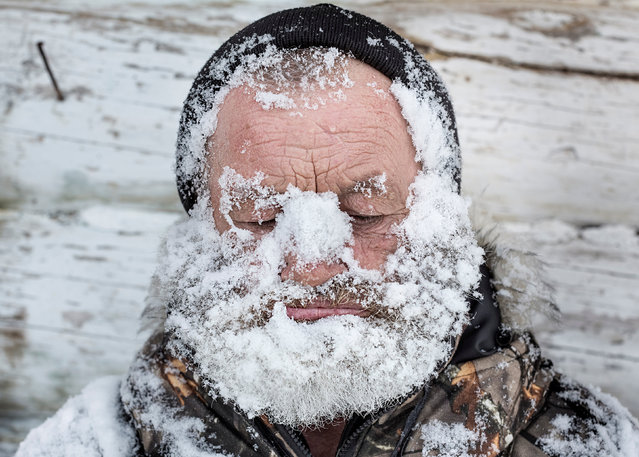
In Russia’s extreme north, century-long ways of life dominate the daily life of some of the most isolated parts of the desolate landscape. Modern civilization penetrates slowly and fragmentarily. There are no roads, and only one helicopter shuttle twice monthly. The residents’ ancestors can be traced back to hereditary hunters in a small settlement near Nizhnyaya Tunguska River, Russia, more than 300 years ago. (Photo by Elena Anosova/Reuters/Courtesy of World Press Photo Foundation)
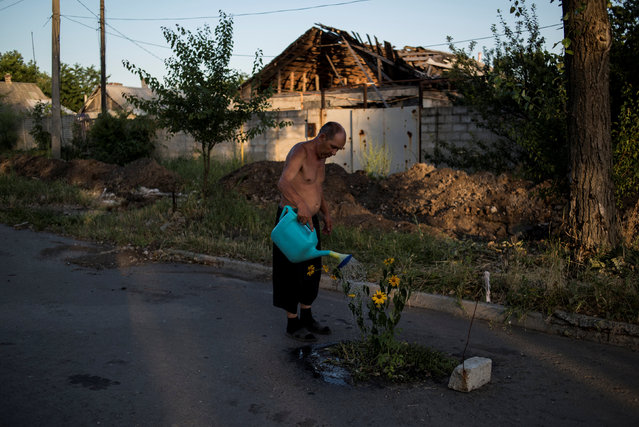
Man watering flowers on a street in the destroyed village of Spartak. Ordinary people became victims of the conflict between self-proclaimed republics and the official Ukrainian authorities from 2014 onwards in the region of Donbass. Disaster came into their lives unexpectedly. These people were involved in the military confrontation against their will. They experienced the most terrible things: the death of their friends and relatives, destroyed homes and the ruined lives of thousands of people. (Photo by Valery Melnikov/Reuters/Rossiya Segodnya/Courtesy of World Press Photo Foundation)
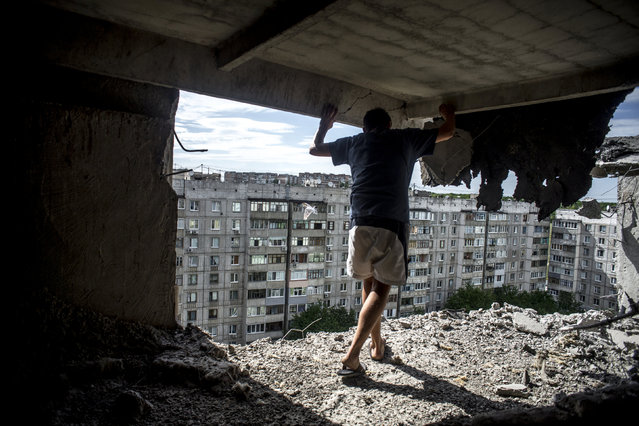
A man inspects damaged building in the Mirny district of Luhansk. (Photo by Valery Melnikov/Reuters/Rossiya Segodnya/Courtesy of World Press Photo Foundation)
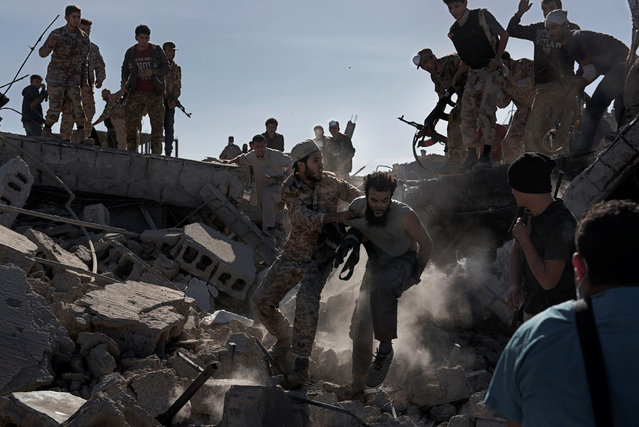
Soon after he surrendered, an ISIS fighter is violently dragged by Libyan fighters affiliated with the government in Tripoli while they shout and threaten to lynch him on December 5, 2016. Few minutes later he was found in the same place shot dead multiple times. (Photo by Alessio Romenzi/Reuters/Courtesy of World Press Photo Foundation)
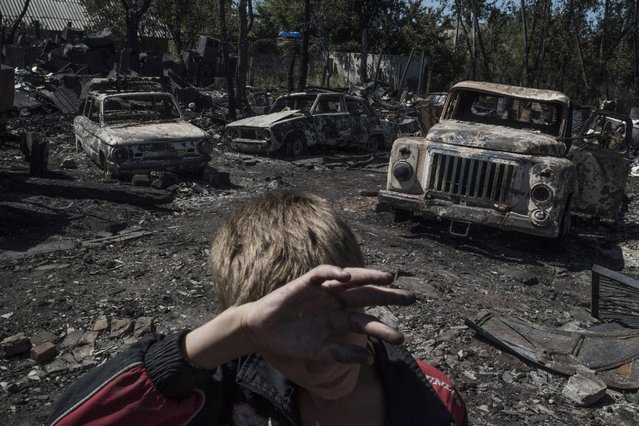
Cars burned by gunfire, July 2, 2014. Civilians escape from a fire at a house destroyed by an air attack in the Luhanskaya village. Ordinary people became victims of the conflict between self-proclaimed republics and the official Ukrainian authorities from 2014 onwards in the region of Donbass. Disaster came into their lives unexpectedly. These people were involved in the military confrontation against their will. They experienced the most terrible things: the death of their friends and relatives, destroyed homes and the ruined lives of thousands of people. (Photo by Valery Melnikov/Reuters/Rossiya Segodny/Courtesy of World Press Photo Foundation)
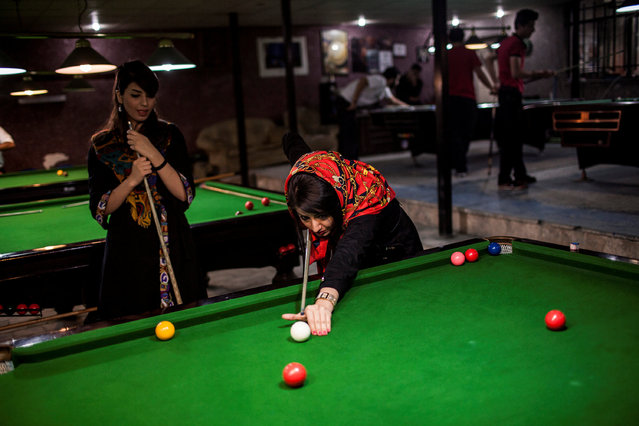
Iran: An Iranian Journey by Hossein Fatemi. Women play pool in a men only gym, which it is forbidden for women to enter. (Photo by Hossein Fatemi/Reuters/Panos Pictures/Courtesy of World Press Photo Foundation)

A Muslim taxi driver prays on the sidewalk while Tara and Soroush, two Iranian students who live downtown, celebrate their wedding day in Tehran, Iran. (Photo by Hossein Fatemi/Reuters/Panos Pictures/Courtesy of World Press Photo Foundation)
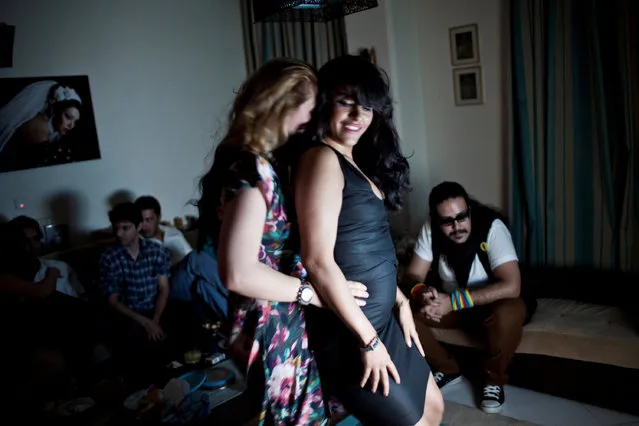
Two young women, having enjoyed a drink at a party, dance together in Tehran, Iran. Although unrelated men and women are forbidden to socialise together many people ignore these strictures in the privacy of their own homes. (Photo by Hossein Fatemi/Reuters/Panos Pictures/Courtesy of World Press Photo Foundation)
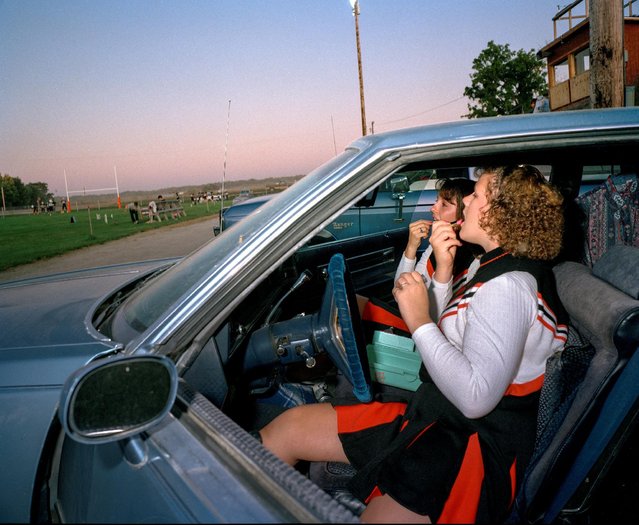
Cheerleaders Melissa Bernadt and Jennifer Burnedt prepare for the evening’s homecoming game, United States. (Photo by Markus Jokela/Reuters/Helsingin Sanomat/Courtesy of World Press Photo Foundation)
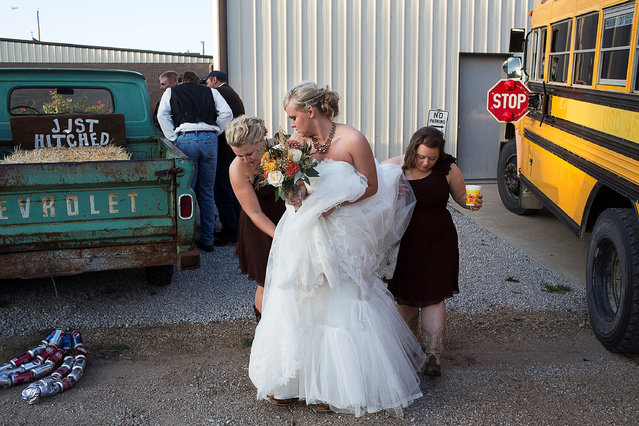
Kelly Freeman arrives at her wedding reception in Dubois, Kansas. (Photo by Markus Jokela/Reuters/Helsingin Sanomat/Courtesy of World Press Photo Foundation)
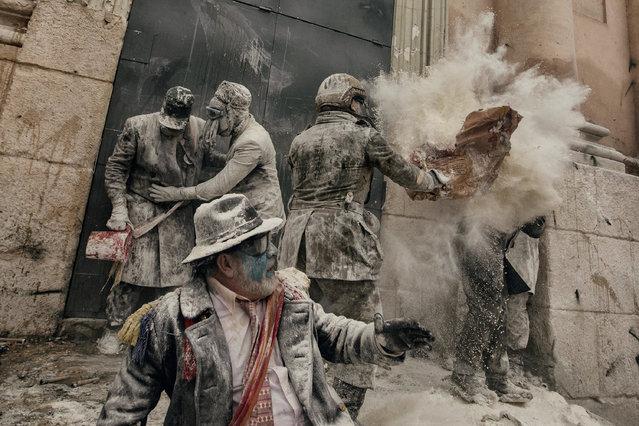
On 28 December each year, the “Floured War” takes place in Ibi in the province of Alicante, Spain. During the festival, the citizens are divided into two groups: the 'Enfarinat' (the floured) group simulates a coup d'etat and a second group tries to calm the rebellion. The teams play with flour, water, eggs and colored smoke bombs. The 200-year-old tradition is known as “Els Enfarinats”, marking the biblical Massacre of the Innocents by King Herod. (Photo by Antonio Gibotta/Reuters/Agenzia Controluce/Courtesy of World Press Photo Foundation)
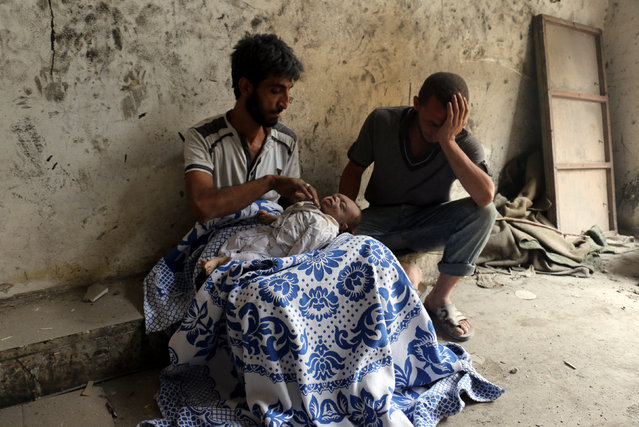
Syrians mourn over the body of a baby following bombardment on Aleppo's al-Marja neighborhood on 23 September 2016. Missiles rained down on rebel-held areas of Aleppo, causing widespread destruction that overwhelmed rescue teams, as the army prepared a ground offensive to retake the city. (Photo by Ameer Alhalbi/AFP Photo/Courtesy of World Press Photo Foundation)

With the aid of chains purchased at the hardware store and deadlift straps, Lindsay performs cleans under the watchful eye of her coach Jenny Jeffries. “It's been an important relationship for me”, says Jeffries, who was admittedly affected by her mother's disabilities following a car accident. “How could it not – seeing Lindsay doing what she's been doing her whole life”. (Photo by Darren Calabrese/Reuters/Courtesy of World Press Photo Foundation)
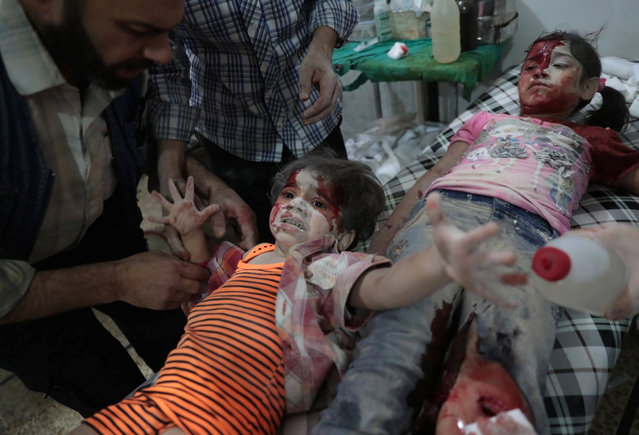
A Syrian girl cries out as a wounded child lies next to her at a makeshift hospital on 12 September 2016. She had been injured in reported government airstrikes on the rebel-held town of Douma, east of Damascus, Syria. (Photo by Abd Doumany/AFP Photo/Courtesy of World Press Photo Foundation)
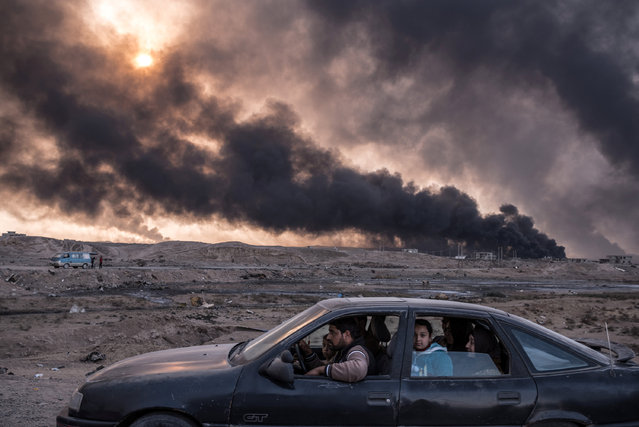
A family flees the fighting in Mosul, Iraq's second-largest city, as oil fields burned in Qayyara, Iraq, on November 12, 2016. In its sixth week, the military campaign to retake Mosul from the Islamic State had bogged down in a grueling fight. Seeking to escape the bloodshed, more civilians than ever took the risk of evacuation, hoping to find help if they could make it past the militants' gun range. By mid-December 2016, up to one million people were trapped inside the city, running low on food and drinking water and facing the worsening cruelty of Islamic State fighters. (Photo by Sergey Ponomarev/Reuters/Courtesy of World Press Photo Foundation)
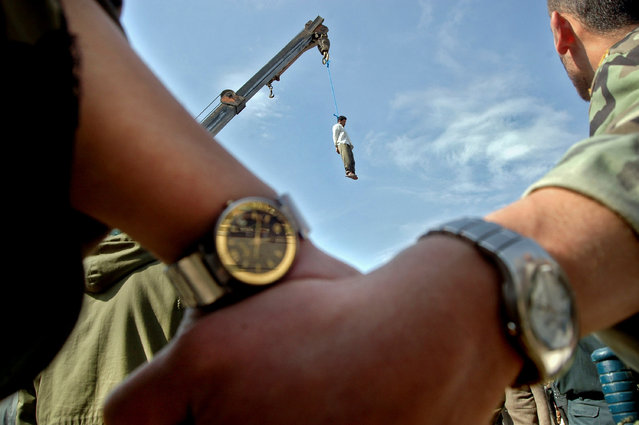
Serial killer Mohammad Bijeh, who was convicted of kidnapping and murdering 21 people, most of them children, is hauled into the air hanging from the arm of a crane after his execution on 16 March, 2005. Bijeh, branded 'the vampire of the desert' in Iran, was lashed 100 times and hanged before thousands of spectators. (Photo by Hossein Fatemi/Reuters/Panos Pictures/Courtesy of World Press Photo Foundation)
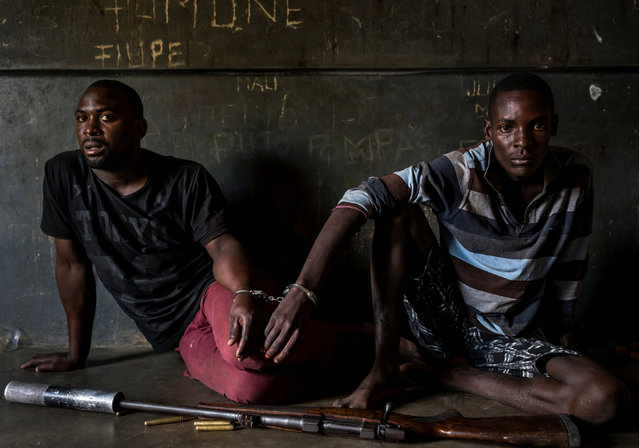
Two rhino poachers, one 19, the other 28 years old, apprehended by an anti-poaching team in Mozambique close to Kruger National Park border. They are seen waiting to be processed in the local jail. After a three-day chase, they were caught in a roadblock and the rifle seized shortly thereafter. This was due to a coordinated effort between Kruger National Park in South Africa where the poachers intended to shoot rhino for their horn; and Sabi Game Park, a conservancy on the Mozambique side. The poachers were tracked and identified by their unique shoe pattern. They tried to say they had been on their way to buy cattle, but had no money on their persons, and when asked the alleged cattle owner said he did not know anything about selling his cattle. A Czech CZ .458 hunting rifle was seized, complete with a professionally built silencer. Both men admitted their guilt and will be charged under new Mozambican law which states that possession of the weapon and bullets indicates intent to poach rhino. This carries a maximum sentence of 12 years and/or $80,000.00. Their Toyota Hilux vehicle was also confiscated. The younger of the two poachers later led police to the homes of suspected weapons and transport suppliers, higher-ups in the rhino poaching syndicates known as level 2's and 3's. Those men had fled by the time the police arrived, but significant information was discovered in the form of identity documents, both real and forged, as well as banking account information. (Photo by Brent Stirton/Getty Images for National Geographic Magazine/Courtesy of World Press Photo Foundation)
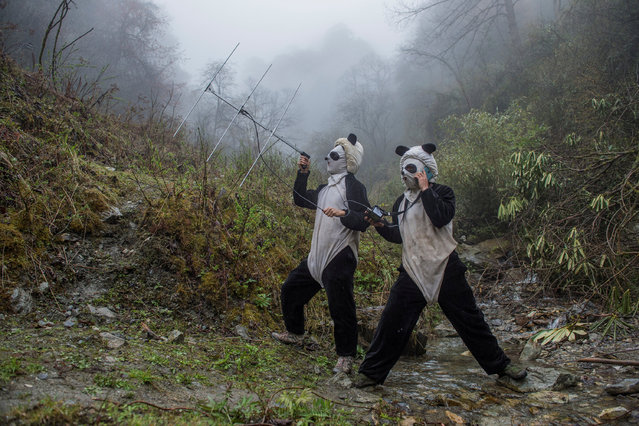
In a large forested enclosure of the Wolong Reserve, panda keepers Ma Li and Liu Xiaoqiang listen for radio signals from a collared panda training to be released to the wild. Tracking can tell them how the cub is faring in the rougher terrain up the mountain. (Photo by Ami Vitale/Reuters/National Geographic Magazine/Courtesy of World Press Photo Foundation)
15 Feb 2017 00:04:00,
post received
0 comments
